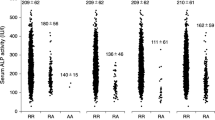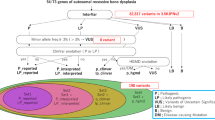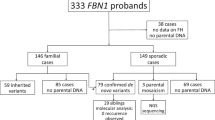Abstract
Albright's hereditary osteodystrophy (AHO) is characterized by short stature, round face, calcifications, obesity, brachydactyly and intellectual disability. AHO without hormone resistance is called pseudopseudohypoparathyroidism (PPHP), a rare clinical condition difficult to diagnose with highly variable features. PPHP is caused by paternally inherited loss-of-function mutations in the GNAS. Patients with 2q37 microdeletions or HDAC4 mutations are also defined as having an AHO-like phenotype with normal stimulatory G (Gs) function. We have studied 256 patients with AHO features but no other diagnosis. Their platelet Gs activity was determined via the aggregation-inhibition test showing Gs hypo- or hyperfuncton in 24% and 15% of the patients, respectively. Before initiating with detailed (epi)genetic GNAS studies, we here wanted to excluded copy number variants (CNVs) in GNAS as cause of AHO with a novel large-scale screening technique. Multiplex amplicon quantification (MAQ) for CNVs screening was developed for the 20q13.3 region including GNAS and potential long-range imprinting control elements such as STX16. This is the first large-scale GNAS CNV study in patients with common AHO features but no CNVs were detected. In conclusion, CNVs in the GNAS region are not likely to cause an AHO-like phenotype with or without abnormal platelet Gs activity. Future studies will be undertaken to find out whether these AHO patients with abnormal Gs function are characterized by GNAS coding or methylation defects.
Similar content being viewed by others
Main
GNAS is an imprinted region that gives rise to several transcripts, antisense transcripts and noncoding RNAs, including transcription of the alpha subunit of the stimulatory G protein (Gsalpha), which interacts with adenylyl cyclase to generate cAMP.1 Several phenotypes resulting from genetic and epigenetic abnormalities of the GNAS region have been described so far. Gsalpha loss-of-function mutations cause Albright's hereditary osteodystrophy (AHO), a spectrum of phenotypic features including short stature, obesity, round face, brachydactyly, subcutaneous ossifications and intellectual disability.1 Patients with maternal inheritance of Gsalpha mutations often develop multi-hormone resistance, and are therefore referred to pseudohypoparathyroidism type Ia (PHP-Ia), whereas pseudohypoparathyroidism type Ib (PHP-Ib) patients, despite presenting also with hormone resistance, do not show overt AHO features. PHP-Ib patients display methylation abnormalities in the GNAS differentially methylated regions, such as NESP hypermethylation versus XL/Nespas and Exon A/B hypomethylation.2 Familial cases of PHP-Ib present with Exon A/B-only hypomethylation3, 4 that appears to be caused by maternally inherited deletions affecting imprinting control centers in either the STX16 gene5, 6 or the NESP55/NESPAS region.2, 7 Paternal Gsalpha-inactivating mutations lead to pseudopseudohypoparathyroidism (PPHP).1, 8, 9 This clinical condition is characterized by highly variable AHO features but no hormone resistance.1, 9, 10 Clinical diagnosis of those patients is particularly difficult because of their phenotypic heterogeneity and the absence of a biochemical marker that could be used, such as PTH and calcium levels, that are determined to diagnose PHP-Ia and PHP-Ib. A firm clinical diagnosis of PPHP may therefore be hard to make, as AHO features can also be nonspecific. Additional diagnostic support for PPHP comes from Gs functional assays. Such tests typically involve the use of the patients' erythrocytes or platelets and have been shown to be able to support the diagnosis of PHP-Ia, some cases of PHP-Ib and also PPHP.11, 12, 13 However, the genotype–Gs function correlation is not always respected as a number of patients have been found to have an AHO phenotype, a Gs loss of function through Gsalpha-coding mutations could not be detected.12 Chromosome 20q paternal uniparental isodisomy has also been described as possible cause of PHP-Ib14, 15, 16 but maternal uniparental isodisomy has never been described for PPHP patients. In addition, an AHO-like phenotype is also described in patients with HDAC4 happloinsufficiency due to gene mutations or 2q37 microdeletions.17, 18
In the last decade, hundreds of submicroscopic copy number variants (CNVs) and inversions have been described in the human genome.19, 20, 21, 22, 23 This type of variants can contain millions of bases of DNA, encompassing entire genes and their regulatory regions.19, 20, 21, 23, 24 CNVs in some genomic regions have no obvious phenotypic consequence,19, 20, 21, 23 whereas others might influence gene dosage leading to genetic diseases either alone or in combination with other genetic or environmental factors.25
Despite the identification of two genomic losses in the GNAS locus26, 27 reported in the Database of Genomic Variants (Center of Applied Genomics), to our knowledge,CNVs in the GNAS cluster were not studied in detail in patients with an AHO-like phenotype (including PPHP cases). We have selected 256 patients with AHO features (including in most cases idiopathic short stature, brachydactyly or the presence of short and broad fingers with/without clinodactyly and/or a variable degree of neurobehavior problems) but none of the patients presented with hormone resistance or having another clinical diagnosis. Before screening this large patient population for GNAS (epi)genetic defects, we set up a large-scale screening technique to exclude GNAS CNVs. In all patients, we have first studied platelet Gs activity as described earlier using the platelet aggregation-inhibition test (Table 1).28 All functional platelet and genetic studies were approved by our institutional Ethics Committee. This test is based on the inhibition of platelet aggregation by cyclic adenosine monophosphate (cAMP) produced by Gs agonists, such as prostaglandin E1 or the stable prostacyclin analog Iloprost, and proved to be reliable in the identification of both Gsalpha hypo- or hyperfunction.28, 29, 30 For 24% and 15% of the 256 patients, we could identify a Gs hypo- or hyperfunction, respectively (Table 1). We have previously described platelet Gs hypofunction in PPHP, PHP-Ia and PHP-Ib cases,28, 30 but platelet Gs hyperfunction was also detected in patients with an AHO-like phenotype including brachydactyly with short stature or neurobehavior problems due to a genetic variant in XlalphaS.29, 31 We here wanted to evaluate the possible influence of specific CNVs combinations in the GNAS region on both the AHO phenotype and the platelet Gs function by including AHO-like patients with normal and abnormal platelet Gs function. To be able to rapidly screen for CNVs in a large sample set of 256 patients, we have developed and optimized a Multiplex amplicon quantification (MAQ) assay32 for the assessment of CNVs in the 20q13.3 region including the complete GNAS locus with all alternative transcripts and the STX16 region that comprises a GNAS imprinting control region.
MAQ is a low-cost and high-throughput PCR-based method that can reliably detect copy number alterations in genomic regions. Differently from MLPA, which is currently the most used technique to study CNVs,33, 34 MAQ is a closed, single tube analysis method, whereas MLPA needs three steps (hybridistaion, ligation and amplification) that requires opening of the test tube during the process.32 In addition, a comparative study between MLPA and MAQ, showed that the MAQarray slightly performed better than the MLPA method in detection of CNVs in neuroblastoma.32 The MAQ assay performed for this study consisted of a multiplex PCR amplification of 18 GNAS target amplicons and 9 reference amplicons (randomly located on different chromosomes) (references of amplicons are in Supplementary Table 1) (Figure 1), followed by fragment analysis on an ABI 3730 DNA Analyzer (Applied Biosystems, Foster City, CA, USA).32 The reaction was carried on 50 ng genomic DNA by using optimized reaction conditions. The comparison of normalized peak areas between patient and control individuals results in a dosage quotient of the target amplicon. Dosage quotients were calculated using the MAQ-S software package (www.multiplicom.com). The complete GNAS MAQ array was performed in duplicate. No statistical differences were observed in GNAS CNVs in all the 256 patients studied, irrespectively of their loss, gain or normal platelet Gs function. The latter suggests that CNVs are not the cause in the present subset of patients neither for the AHO phenotype nor for the Gs abnormal function in their platelets. Therefore, it might be more appropriate to first exclude the known causes of AHO by (epi)genetic screening of the GNAS cluster, before analyzing AHO patients with other genetic screening methods.
In conclusion, we here have optimized the first rapid large-scale screening method for GNAS CNVs and have applied it to a population of 256 patients with AHO features but no endocrinopathy with or without abnormal platelet Gs function. Future studies will include the GNAS sequencing and methylation analysis of these AHO-like patients with abnormal platelet Gs function. In addition, patients without GNAS (epi)genetic mutations also need to be screened for 2q37 deletions or HDAC4 mutations.
References
Bastepe, M. & Juppner, H. GNAS locus and pseudohypoparathyroidism. Horm. Res. 63, 65–74 (2005).
Bastepe, M., Frohlich, L. F., Linglart, A., Abu-Zahra, H. S., Tojo, K., Ward, L. M. et al. Deletion of the NESP55 differentially methylated region causes loss of maternal GNAS imprints and pseudohypoparathyroidism type Ib. Nat. Genet. 37, 25–27 (2005).
Linglart, A., Bastepe, M. & Juppner, H. Similar clinical and laboratory findings in patients with symptomatic autosomal dominant and sporadic pseudohypoparathyroidism type Ib despite different epigenetic changes at the GNAS locus. Clin. Endocrinol. 67, 822–831 (2007).
Liu, J., Nealon, J. G. & Weinstein, L. S. Distinct patterns of abnormal GNAS imprinting in familial and sporadic pseudohypoparathyroidism type IB. Hum. Mol. Genet. 14, 95–102 (2005).
Bastepe, M., Frohlich, L. F., Hendy, G. N., Indridason, O. S., Josse, R. G., Koshiyama, H. et al. Autosomal dominant pseudohypoparathyroidism type Ib is associated with a heterozygous microdeletion that likely disrupts a putative imprinting control element of GNAS. J. Clin. Invest. 112, 1255–1263 (2003).
Linglart, A., Gensure, R. C., Olney, R. C., Juppner, H. & Bastepe, M. A novel STX16 deletion in autosomal dominant pseudohypoparathyroidism type Ib redefines the boundaries of a cis-acting imprinting control element of GNAS. Am. J. Hum. Genet. 76, 804–814 (2005).
Chillambhi, S., Turan, S., Hwang, D. Y., Chen, H. C., Juppner, H. & Bastepe, M. Deletion of the noncoding GNAS antisense transcript causes pseudohypoparathyroidism type Ib and biparental defects of GNAS methylation in cis. J. Clin. Endocrinol. Metab. 95, 3993–4002 (2010).
Wilson, L. C., Oude Luttikhuis, M. E., Clayton, P. T., Fraser, W. D. & Trembath, R. C. Parental origin of Gs alpha gene mutations in Albright's hereditary osteodystrophy. J. Med. Genet. 31, 835–839 (1994).
Davies, S. J. & Hughes, H. E. Imprinting in Albright's hereditary osteodystrophy. J. Med. Genet. 30, 101–103 (1993).
Wilson, L. C. & Trembath, R. C. Albright's hereditary osteodystrophy. J. Med. Genet. 31, 779–784 (1994).
Freson, K., Izzi, B., Jaeken, J., Van Helvoirt, M., Thys, C., Wittevrongel, C. et al. Compound heterozygous mutations in the GNAS gene of a boy with morbid obesity, thyroid-stimulating hormone resistance, pseudohypoparathyroidism, and a prothrombotic state. J. Clin. Endocrinol. Metab. 93, 4844–4849 (2008).
Ahrens, W. & Hiort, O. Determination of Gs alpha protein activity in Albright's hereditary osteodystrophy. J. Pediatr. Endocrinol. Metab. 19 (Suppl 2), 647–651 (2006).
Zazo, C., Thiele, S., Martin, C., Fernandez-Rebollo, E., Martinez-Indart, L., Werner, R. et al. Gsalpha activity is reduced in erythrocyte membranes of patients with pseudohypoparathyrodism due to epigenetic alterations at the GNAS locus. J. Bone Miner. Res. 26, 1864–70 (2011).
Bastepe, M., Lane, A. H. & Juppner, H. Paternal uniparental isodisomy of chromosome 20q--and the resulting changes in GNAS1 methylation--as a plausible cause of pseudohypoparathyroidism. Am. J. Hum. Genet. 68, 1283–1289 (2001).
Fernandez-Rebollo, E., Lecumberri, B., Garin, I., Arroyo, J., Bernal-Chico, A., Goni, F. et al. New mechanisms involved in paternal 20q disomy associated with pseudohypoparathyroidism. Eur. J. Endocrinol. 163, 953–962 (2010).
Bastepe, M., Altug-Teber, O., Agarwal, C., Oberfield, S. E., Bonin, M. & Juppner, H. Paternal uniparental isodisomy of the entire chromosome 20 as a molecular cause of pseudohypoparathyroidism type Ib (PHP-Ib). Bone 48, 659–662 (2011).
Wilson, L. C., Leverton, K., Oude Luttikhuis, M. E., Oley, C. A., Flint, J., Wolstenholme, J. et al. Brachydactyly and mental retardation: an Albright hereditary osteodystrophy-like syndrome localized to 2q37. Am. J. Hum. Genet. 56, 400–407 (1995).
Williams, S. R., Aldred, M. A., Der Kaloustian, V. M., Halal, F., Gowans, G., McLeod, D. R. et al. Haploinsufficiency of HDAC4 causes brachydactyly mental retardation syndrome, with brachydactyly type E, developmental delays, and behavioral problems. Am. J. Hum. Genet. 87, 219–228 (2010).
Sebat, J., Lakshmi, B., Troge, J., Alexander, J., Young, J., Lundin, P. et al. Large-scale copy number polymorphism in the human genome. Science 305, 525–528 (2004).
Iafrate, A. J., Feuk, L., Rivera, M. N., Listewnik, M. L., Donahoe, P. K., Qi, Y. et al. Detection of large-scale variation in the human genome. Nat. Genet. 36, 949–951 (2004).
Tuzun, E., Sharp, A. J., Bailey, J. A., Kaul, R., Morrison, V. A., Pertz, L. M. et al. Fine-scale structural variation of the human genome. Nat. Genet. 37, 727–732 (2005).
Dhami, P., Coffey, A. J., Abbs, S., Vermeesch, J. R., Dumanski, J. P., Woodward, K. J. et al. Exon array CGH: detection of copy-number changes at the resolution of individual exons in the human genome. Am. J. Hum. Genet. 76, 750–762 (2005).
Sharp, A. J., Locke, D. P., McGrath, S. D., Cheng, Z., Bailey, J. A., Vallente, R. U. et al. Segmental duplications and copy-number variation in the human genome. Am. J. Hum. Genet. 77, 78–88 (2005).
Stefansson, H., Helgason, A., Thorleifsson, G., Steinthorsdottir, V., Masson, G., Barnard, J. et al. A common inversion under selection in Europeans. Nat. Genet. 37, 129–137 (2005).
Inoue, K. & Lupski, J. R. Molecular mechanisms for genomic disorders. Annu. Rev. Genomics. Hum. Genet. 3, 199–242 (2002).
Park, C. H., Rha, S. Y., Jeung, H. C., Kang, S. H., Ki, D. H., Lee, W. S. et al. Identification of novel gastric cancer-associated CNVs by integrated analysis of microarray. J. Surg. Oncol. 102, 454–461 (2010).
Conrad, D. F., Pinto, D., Redon, R., Feuk, L., Gokcumen, O., Zhang, Y. et al. Origins and functional impact of copy number variation in the human genome. Nature 464, 704–712 (2010).
Freson, K., Izzi, B., Labarque, V., Van Helvoirt, M., Thys, C., Wittevrongel, C. et al. GNAS defects identified by stimulatory G protein alpha-subunit signalling studies in platelets. J. Clin. Endocrinol. Metab. 93, 4851–4859 (2008).
Freson, K., Hoylaerts, M. F., Jaeken, J., Eyssen, M., Arnout, J., Vermylen, J. et al. Genetic variation of the extra-large stimulatory G protein alpha-subunit leads to Gs hyperfunction in platelets and is a risk factor for bleeding. Thromb. Haemost. 86, 733–738 (2001).
Freson, K., Thys, C., Wittevrongel, C., Proesmans, W., Hoylaerts, M. F., Vermylen, J. et al. Pseudohypoparathyroidism type Ib with disturbed imprinting in the GNAS1 cluster and Gsalpha deficiency in platelets. Hum. Mol. Genet. 11, 2741–2750 (2002).
Freson, K., Jaeken, J., Van Helvoirt, M., de Zegher, F., Wittevrongel, C., Thys, C. et al. Functional polymorphisms in the paternally expressed XLalphas and its cofactor ALEX decrease their mutual interaction and enhance receptor-mediated cAMP formation. Hum. Mol. Genet. 12, 1121–1130 (2003).
Kumps, C., Van Roy, N., Heyrman, L., Goossens, D., Del-Favero, J., Noguera, R. et al. Multiplex Amplicon Quantification (MAQ), a fast and efficient method for the simultaneous detection of copy number alterations in neuroblastoma. BMC. Genomics. 11, 298 (2010).
den Dunnen, J. T. & White, S. J. MLPA and MAPH: sensitive detection of deletions and duplications. Curr. Protoc. Hum. Genet, Chapter 7, Unit 7.14, doi:10.1002/0471142905.hg0714s51 (2006).
Kozlowski, P., Jasinska, A. J. & Kwiatkowski, D. J. New applications and developments in the use of multiplex ligation-dependent probe amplification. Electrophoresis 29, 4627–4636 (2008).
Acknowledgements
Supported by the ‘Excellentie financiering KULeuven’ (EF/05/013), by research grants 1.5.038.08N, G.0490.10N and G.0743.09 from the FWO-Vlaanderen (Belgium) and by GOA/2009/13 from the Research Council of the University of Leuven (Onderzoeksraad KULeuven, Belgium). CVG is holder of a clinical-fundamental research mandate of the Fund for Scientific Research-Flanders (FWO-Vlaanderen, Belgium and of the Bayer and Norbert Heimburger (CSL Behring) Chairs.
Author information
Authors and Affiliations
Corresponding author
Additional information
Supplementary Information accompanies the paper on Journal of Human Genetics website
Supplementary information
Rights and permissions
About this article
Cite this article
Izzi, B., Zegher, F., Francois, I. et al. No evidence for GNAS copy number variants in patients with features of Albright's hereditary osteodystrophy and abnormal platelet Gs activity. J Hum Genet 57, 277–279 (2012). https://doi.org/10.1038/jhg.2012.1
Received:
Revised:
Accepted:
Published:
Issue Date:
DOI: https://doi.org/10.1038/jhg.2012.1




